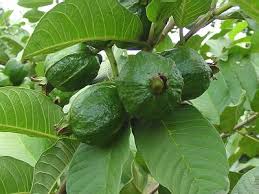scientific name — Psidium guajava L
 or guava is a tropical plant, which is locally known for its edible fruit. In the backyards of Filipino homes in the country, this plant is commonly seen, and grown because of its many uses as fruit and as traditional remedy to treat various ailments. As shown by many research studies, almost all of the parts of this plant have medicinal qualities and value, and thus, making it as one of the most popular therapeutic plants in the Philippines. Bayabas is a small tree that can grow up to 3 meters tall with greenish-brownish smooth bark. The round globular bayabas fruit starts as a flower and is usually harvested and eaten while still green. The fruit turns yellowish-green and soft when ripe.
or guava is a tropical plant, which is locally known for its edible fruit. In the backyards of Filipino homes in the country, this plant is commonly seen, and grown because of its many uses as fruit and as traditional remedy to treat various ailments. As shown by many research studies, almost all of the parts of this plant have medicinal qualities and value, and thus, making it as one of the most popular therapeutic plants in the Philippines. Bayabas is a small tree that can grow up to 3 meters tall with greenish-brownish smooth bark. The round globular bayabas fruit starts as a flower and is usually harvested and eaten while still green. The fruit turns yellowish-green and soft when ripe.
The bayabas fruit bark and leaves are used as herbal medicine. Its leaves decoction is recognized for its effectiveness to cure several ailments, including the treatment of uterine hemorrhage, swollenness of the legs and other parts of the body, of chronic diarrhea, and gastroenteritis, among others. The most common use of the leaves is for cleaning and disinfecting wounds by rinsing the afflicted area with a decoction of the leaves. In the same way, such leaves are being used to aid in the treatment of dysentery and the inflammation of the kidneys. The bark and leaves can be used as astringent. It can also be used as a wash for uterine and vaginal problems, and is good for ulcers. The medicinal uses of Bayabas appear infinite, as it is also a suggested natural cure for fevers, diabetes, epilepsy, worms, and spasms. The fruit, aside from being delicious, contains nutritional values with a very high concentration of vitamin A and vitamin C
The bayabas fruit bark and leaves are used as herbal medicine. Its leaves decoction is recognized for its effectiveness to cure several ailments, including the treatment of uterine hemorrhage, swollenness of the legs and other parts of the body, of chronic diarrhea, and gastroenteritis, among others. The most common use of the leaves is for cleaning and disinfecting wounds by rinsing the afflicted area with a decoction of the leaves. In the same way, such leaves are being used to aid in the treatment of dysentery and the inflammation of the kidneys. The bark and leaves can be used as astringent. It can also be used as a wash for uterine and vaginal problems, and is good for ulcers. The medicinal uses of Bayabas appear infinite, as it is also a suggested natural cure for fevers, diabetes, epilepsy, worms, and spasms. The fruit, aside from being delicious, contains nutritional values with a very high concentration of vitamin A and vitamin C










0 comments:
Post a Comment